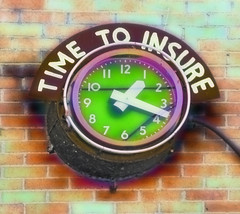Time will come today

Image by carljohnson via Flickr
After reading Daniel Walker Howe’s brilliant history of the transformation of the U.S. in the early 1800s, What Hath God Wrought, and then researching a brief story on the establishment of Albany Time, I realized that our approach to time has become standardized, perfect, and wrong. Reading Ian Bartky’s Selling the True Time only reinforces my wonder that we have transformed time from the local true time to something that is delivered from a distant location and that is nearly always wrong.
They say that even a broken clock is right twice a day. Ironically, our highly synchronized clocks, now tied in to official timeservers by high-speed internet connections, are almost never right.
It’s commonly thought that in olden days, time was set by solar noon, the point at which the sun is highest in the sky. Not really true, because it was understood early on that the earth actually rotates 361 degrees each day in relation to the sun, making the solar day a very inaccurate time reference (not to mention the difficulty of measuring the position of a disk that takes up such a large space in the sky and blinds you as you stare at it — leading to the stereotype of the squinty-eyed sailor). Instead, astronomers adopted sidereal time, measuring the earth’s rotation against the night sky, setting a day according to a normal 360-degree rotation. As the use of accurate clocks and watches spread widely in the 19th century, it was common for local jewelers and clockmakers to keep the correct time: local sidereal time. These merchants often were, or were assisted by, amateur astronomers, armed with star charts from Europe and the established reference of the Greenwich observatory, who would frequently set local time with a fair degree of accuracy. So here in Albany, the local watchmaker on Pearl Street was where you went to find out what time it was. And if you took the train to Syracuse, you might step off the train and go across the street to another jeweler to check the time, because it is about 9 minutes earlier in Syracuse than in Albany. That’s how time really works: it’s tied to your longitude, and even a small distance on the planet can make a significant difference in what time it is.
Came the telegraph, railroads and professional astronomers, and the case was made that for the sake of safety, to prevent rail collisions in the days before electric track signaling, trains should all run on the same time. In 1883, the railroads adopted the Standard Time system, breaking the U.S. into four time zones. (Standard time wasn’t established by federal law until 1918.) Most major cities, highly dependent on the railroads for the flow of commerce, adjusted their official time to railroad standard time. Suddenly, when it was noon in Boston, it was noon in Detroit – a convenience, but a patent falsehood, as these two cities are 47 minutes apart. But standard time was universally adopted, and became more and more important to commerce as communications sped up and the world got smaller.
In the early days of personal computers and the web, one of the exciting things was that you could suddenly get highly accurate time through your computer — much easier than placing the call to the local time and temperature line and then walking around the house to set your clocks, guessing how long it had been since you got the time as you moved from room to room. It used to require a program; now it’s built right in to the computer, the phone, the cable box, the Playstation. There’s perfect standard time all over my house – and it even adjusts to the lie we tell ourselves, daylight savings time, to enjoy longer summer evenings. We’ve transformed from having highly accurate time in the 19th century to being completely wrong in the 21st.
So we still commonly think that noon is the point when the sun is highest in the sky (which it is, if you’re talking about solar noon) — but solar noon here in Albany, during daylight savings time, is at 1:04:10 PM. Solar noon in Detroit is at 1:41:31 PM. But if I’m on a phone call with someone in Detroit, at noon today, we’ll both get on the phone at the same time and the sun won’t be near its highest point in the sky. Our time is highly accurate and completely wrong.

